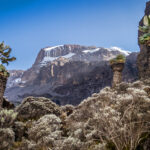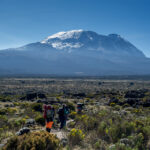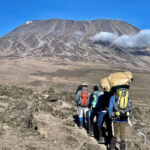 Helichrysum newii’s white flowers look almost like mountain daisies.
Helichrysum newii’s white flowers look almost like mountain daisies.
“Everlasting Flower” by Flickr user mitchpa1984 licensed under CC BY 2.0
A climb up Kilimanjaro isn’t just a physical challenge, it’s a botany lesson; as you travel through the various climate zones, the flora changes dramatically, from fields of coffee in the foothills to tiny patches of the hardiest lichens near the top. Along the way, hundreds of plant species flourish in Kili’s volcanic soil, and some of them—like the towering giant groundsels—have managed to adapt themselves specifically to the increasingly harsh environment at higher elevations.
One of the hardiest of these floral trekkers is the Helichyrsum family of flowers, more commonly known as everlasting flowers.
Why such an impressive title? They’re the highest flowering plant on the mountain, reaching elevations of around 15,000 feet, where the majority of their near neighbors are small, scraggly shrubs, and the alien-looking groundsels that tower overhead, covered in the withered leaves of years past.
There are a few different varieties of everlastings: Helichrysum meyer-johannis blooms red with a pink center; H. kilimanjari is a yellowish-brown shade, with refreshing, lemon-scented leaves; and H. newii’s white flowers, with each petal tapering to a tiny point, are almost indistinguishable, from afar, from the ghostly-pale leaves that shoot off its branching stalks.
The plants may look pretty, but make no mistake: these are no wilting lilies. A stiff, dry structure helps the everlastings survive the scant moisture and frosty nights on the heath and moorlands, and intricately overlapping petals snap closed at night, further protecting the plant against both cold and water-loss.
But it’s just that sort of tenacity that makes the flowers such a wonderful symbol of a successful trek. That’s probably why for years, trekkers would be greeted upon their descent with a necklace woven from the flowers.






